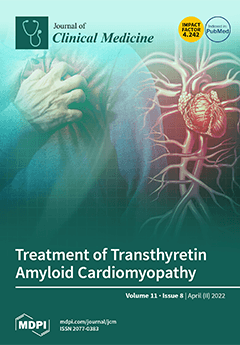(1) Long-term data on maxillary implant overdentures (IODs) are scarce. This case series evaluated three types of IODs supported by six, four or three implants (Anyridge
®, Mega’Gen Implant Co., Ltd., Daegu, South-Korea), after 3–5 years in function. (2) A total of
[...] Read more.
(1) Long-term data on maxillary implant overdentures (IODs) are scarce. This case series evaluated three types of IODs supported by six, four or three implants (Anyridge
®, Mega’Gen Implant Co., Ltd., Daegu, South-Korea), after 3–5 years in function. (2) A total of 31 patients, with 132 implants, were non-randomly allocated based on available bone or financial limitations. IOD-6 received a telescopic overdenture; IOD-4 a bar; and IOD-3, non-connected implants with locator abutments. Implant survival, bone level changes, probing pocket depth (PPD), plaque index, bleeding on probing (BOP), and technical, biological and aesthetic complications were registered. Impact of suprastructures on bone loss and PPD was analyzed using mixed-effect linear regression models. Differences between groups were analyzed using the ANOVA test for BOP, and Kruskal Wallis test for complications. (3) In total, 23 patients participated in the follow-up (9 female, 14 male), with average age of 62.2 years; 7, 11 and 5 patients in IOD-6, IOD-4 and IOD-3, respectively. Implant survival after 4.4 years on average, was 98% in total; 100%, 97.8% and 93.3% for IOD-6, IOD-4 and IOD-3, respectively. Mean bone loss corresponded to 0.68 mm (SD 1.06, range −4.57–1.51), 0.39 mm (SD 1.06, range −3.6–2.43), and 1.42 mm (SD 1.68, range −5.11–0.74) for IOD-6, IOD-4 and IOD-3, respectively. A statistically significant difference was seen in bone level when comparing IOD-6 to IOD-3 (
p = 0.044), and IOD-4 to IOD-3 (
p = 0.018). Mean PPD was 3.8 mm (SD: 0.69; range 2.5–5.3), 3.5 mm (SD 0.59; range 2.33–5), and 3.2 mm (SD 0.56; range 2–4) for IOD-6, IOD-4 and IOD-3, respectively, and differed significantly between IOD-6 and IOD-3 (
p = 0.029). Incidence of peri-implantitis was 1%. No differences were seen for complications between groups. (4) Maxillary IOD supported by four to six implants is the most reliable treatment regarding implant survival and peri-implant health. More research is needed in the clinical outcomes, in particular the peri-implant health, and complications of maxillary IODs, especially with a reduced number of implants.
Full article






